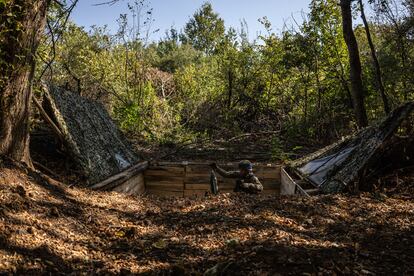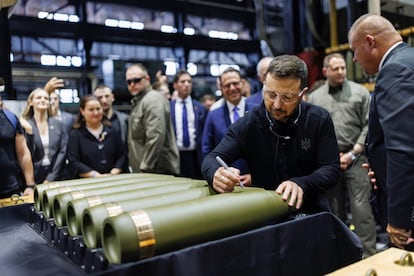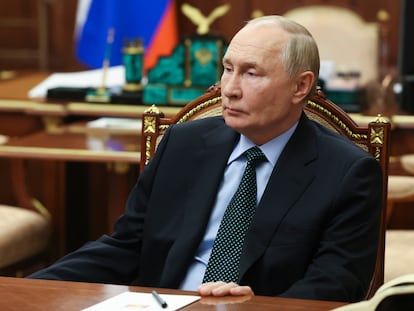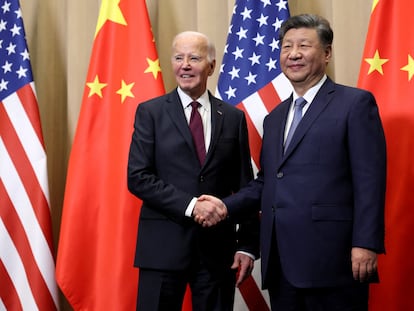US missiles inside Russia: A major political decision with limited impact on Ukraine war
Ukrainian analysts and media argue Biden’s decision to authorize strikes within Russian territory comes too late, and will have little effect if the weapon cannot be used beyond Kursk

The fine print of a contract is often decisive, and it is here that Ukrainian media have focused their attention after learning that Washington authorized Kyiv’s troops to use long-range U.S. Army Tactical Missile Systems, or ATACMS, against Russia. This decision — a politically significant move as it challenges Russia’s threat of escalating the conflict — comes more than a year after Ukraine’s persistent requests and with less than two months remaining in Joe Biden’s presidency. Ukraine is containing its optimism, as many believe the decision comes too late to alter the course of the war, especially since the fine print stipulates that the ATACMS can only target sites in the Russian province of Kursk.
Although there has been no official confirmation from the U.S., Ukrainian President Volodymyr Zelenskiy confirmed that Washington had authorized the use of the long-range missiles in a message late Sunday: “Strikes are not carried out with words. Such things are not announced. Missiles will speak for themselves.”

In August, the Ukrainian Armed Forces began a partial occupation of the Russian region of Kursk, which borders Ukraine’s Sumi province. The operation — a decision made personally by President Zelenskiy — has several key objectives: to show the Kremlin that its territory is vulnerable, to force the Russian army to divert troops from other parts of the front to Kursk, and to gain leverage for future peace negotiations.
Russian counteroffensive at Kursk
Ukraine has since lost a third of the Kursk territory it had occupied, with Russian forces under Commander-in-Chief Valery Gerasimov launching a counteroffensive, supported by more than 10,000 North Korean soldiers, according to Western intelligence reports. The Pentagon cited the presence of North Korean troops as justification for finally approving the use of ATACMS missiles. Although Ukraine has had these weapons in its arsenal since 2023, they were initially restricted to use within Ukraine’s borders.
The key question is whether, as reported by U.S. media, the ATACMS can only be used against Russian positions in Kursk. If this is the case, Washington’s decision to authorize the long-range missiles will have a limited impact on the war, as Ukraine is already targeting this area with American-made Himars missiles. These precision-guided missiles have a range of 50 miles, and have been used to hit bridges, anti-aircraft systems, and concentrations of military equipment. The ATACMS, which can be fired from the same Himars batteries, has a range of 190 miles, allowing it to strike from a greater distance — reducing the risk of the launcher being detected and destroyed.
The Institute for the Study of War (ISW), a U.S. military think tank, argues that limiting the ATACMS to Kursk is a setback for Ukraine. They suggest that the real shift would come if Kyiv were given permission to “strike all legitimate military targets within Russia’s operational and deep-rear within range of US-provided weapons – not just those in Kursk.”
Ukrainian military sources told the military news outlet The War Zone that the ATACMS are a “strategic deterrence conventional weapon in current circumstances.” In other words, the weapons are intended to keep the Kremlin on alert before making certain decisions. These sources also emphasize the need to extend the ATACMS’s reach beyond Ukraine’s borders, and said the weapon should be used to target not only military installations but also Russia’s energy infrastructure. The Ukrainian energy grid, which has already been targeted in massive bombings by Russia, remains vulnerable, with power outages continuing across the country.
John Helin, a researcher at the Finnish defense analysis group Black Bird, points out that Russian forces have already relocated many of their air units and logistics bases to put them out of range of ATACMS — a move that senior Ukrainian military officials have been warning about since 2023. “The Russians have already moved many of their air units out of range of ATACMS. Limiting this weapon to Kursk will also add further limitations. The Russians will probably reorganize their command posts, logistics posts, and air bases so that they are not so exposed in Kursk,” says Helin, who argues this could still work to Ukraine’s advantage, as it would create more physical distance between Russian military positions, potentially slowing their response time.
Confidential figures
The War Zone concludes that a key unknown is the number of ATACMS units Ukraine will receive, a figure that remains confidential. Serhiy Zgurets, director of the Defense Express military research group, estimated that it could be around 100 units. Ukraine’s Air Force is also expected to receive around 100 British-French Storm Shadow/SCALP long-range missiles. According to ISW, there are nearly 250 Russian military facilities involved in the invasion within the ATACMS range (beyond Kursk). The Storm Shadow/SCALP missiles have an even longer range than the ATACMS, at 350 miles
In Ukraine, it is widely believed that Biden’s decision will prompt France and the U.K. to authorize the use of their missiles against Russian targets. Le Figaro reported that both governments had given their approval, but the information was later removed from the newspaper’s website. Ukrainian news agency RBC also cited anonymous sources saying that France and the U.K. had agreed to limit their missile use to Kursk.
Germany, which has the Taurus long-range missile, continues to refuse to transfer these weapons to Kyiv. However, Bild reported that the German Ministry of Defense has agreed to deliver 4,000 long-range bomb-carrying drones capable of targeting Russian sites. These drones have proven to be one of Ukraine’s most significant threats to Russia, with periodic strikes occurring more than 620 miles from the Ukrainian border.
Too late
The news about the ATACMS has been met with mixed reactions in Ukraine. “This is a tale of wasted time. And what’s worse, lives have been lost throughout the entire history of [Western] arms supplies. It won’t change the situation significantly, but it will make it a little easier for us and a little harder for them,” political analyst Yurii Bogdanov wrote in the Ukrainian newspaper Espreso.
The relationship between Zelenskiy and his allied countries has been marked by persistence and diplomatic pressure. Be it ATACMS, Leopard and Abrams tanks, F-16 planes, or Patriot anti-aircraft missiles, the pattern has remained the same: after months of refusals, NATO powers have finally authorized their use. These delays, as noted by European diplomacy chief Josep Borrell in an interview with EL PAÍS on November 11, have been a significant setback for Ukraine.
The imminent use of the ATACMS against Russian targets, as implied by Zelenskiy’s remarks, will reveal whether the Kursk border is truly a limitation or just a stepping stone for further strikes into Russian territory. Biden has only a few weeks left to decide whether to expand ATACMS operational reach before Donald Trump, who advocates for ending the war swiftly — potentially at Ukraine’s expense — takes over the U.S. presidency in January. Helin sees Biden’s decision as a way of pressuring Trump to continue supporting Ukraine. “It all depends on perspective,” says Helin. “It seems good to help the Ukrainians, but it’s coming too late to significantly affect the war, especially if it’s limited to just one territory.”
Sign up for our weekly newsletter to get more English-language news coverage from EL PAÍS USA Edition
Tu suscripción se está usando en otro dispositivo
¿Quieres añadir otro usuario a tu suscripción?
Si continúas leyendo en este dispositivo, no se podrá leer en el otro.
FlechaTu suscripción se está usando en otro dispositivo y solo puedes acceder a EL PAÍS desde un dispositivo a la vez.
Si quieres compartir tu cuenta, cambia tu suscripción a la modalidad Premium, así podrás añadir otro usuario. Cada uno accederá con su propia cuenta de email, lo que os permitirá personalizar vuestra experiencia en EL PAÍS.
¿Tienes una suscripción de empresa? Accede aquí para contratar más cuentas.
En el caso de no saber quién está usando tu cuenta, te recomendamos cambiar tu contraseña aquí.
Si decides continuar compartiendo tu cuenta, este mensaje se mostrará en tu dispositivo y en el de la otra persona que está usando tu cuenta de forma indefinida, afectando a tu experiencia de lectura. Puedes consultar aquí los términos y condiciones de la suscripción digital.
More information
Archived In
Últimas noticias
Cubans look to Venezuela fearfully after Trump’s incursion: ‘We could be next’
The operation in Venezuela to capture Maduro threatens to widen the cracks in the MAGA movement
Trump clarifies who is ultimately in charge in Venezuela: ‘Me’
Maduro pleads not guilty before the federal court in New York: ‘I am still the president of Venezuela’
Most viewed
- Alain Aspect, Nobel laureate in physics: ‘Einstein was so smart that he would have had to recognize quantum entanglement’
- Gilles Lipovetsky: ‘If you want to live better and fall in love, take Prozac, don’t look to philosophy’
- Alvin Hellerstein, a 92-year-old judge appointed by Bill Clinton, to preside over Maduro’s trial in New York
- Cuba confirms death of 32 of its citizens in the US attack against Venezuela
- Why oil has been at the center of Venezuela-US conflicts for decades











































